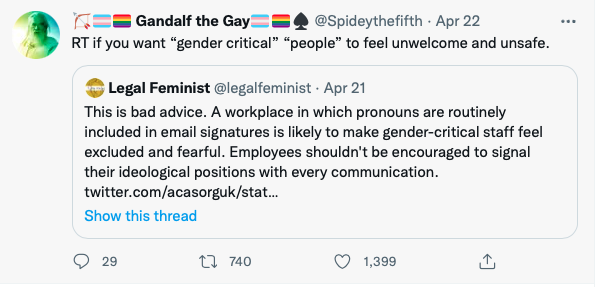The decision is out in Allison Bailey’s appeal against the decision of the Employment Tribunal that Stonewall did not contravene s.111 Equality Act 2010. The Employment Appeal Tribunal has upheld the decision.
The ET is the first instance tribunal. The EAT is the appellate tribunal which heard the appeal from the ET. Any onward appeal must go to the Court of Appeal – and can only be heard if permission is granted and if it satisfies the “second appeal test” of establishing an important principle or there is some other good reason for it to be heard.
Allison Bailey was a barrister at Garden Court Chambers. A seasoned campaigner for lesbian and gay rights, she found herself in profound disagreement with the proposition then being advanced by Stonewall that some men were ‘truly’ lesbians, including those who had no intention of making a physical transition, if they said that they were.
Both Ms Bailey and Stonewall made known their own views on this topic on Twitter. As a result of Ms Bailey’s tweets, Stonewall’s then Head of Trans Inclusion Kirrin Medcalf sent a complaint to Garden Court Chambers saying that “for Garden Court Chambers to continue associating with [Ms Bailey] puts us in a difficult position with yourselves” and that Stonewall trusted Garden Court “would do what is right and stand in solidarity with trans people.”
The detriments to which Garden Court Chambers then subjected Ms Bailey on the basis of her protected belief are set out in the ET decision and were found proved by the ET, which found that Garden Court had unlawfully discriminated against her, including by upholding Medcalf’s complaint against her. However, the ET did not find that Stonewall, through Kirrin Medcalf, had “induced” or “caused” that discrimination.
She appealed to the EAT.
Section 111 Equality Act 2010 prohibits anyone from instructing, causing or inducing another to discrimination against another:
111 Instructing, causing or inducing contraventions
(1) A person (A) must not instruct another (B) to do in relation to a third person (C) anything which contravenes Part 3, 4, 5, 6 or 7 or section 108(1) or (2) or 112(1) (a basic contravention).
(2) A person (A) must not cause another (B) to do in relation to a third person (C) anything which is a basic contravention.
(3) A person (A) must not induce another (B) to do in relation to a third person (C) anything which is a basic contravention.
(4) For the purposes of subsection (3), inducement may be direct or indirect.
…
The EAT had to consider what these meant, which is not something previously attempted by a court. Bourne J held that
- In section 111(1), “It is in the nature of an instruction that the instructor intends the instructee to do something specific. Person A need not be aware that the instructed act will be unlawful, but they must know what it is that they are instructing person B to do, and that act, as instructed, must contain all the elements of whichever of the statutory torts that person B will commit by following the instruction.” [101]
- the word “induce” in section 111(3) “is broadly synonymous with “persuade”. In one case it could consist of pure verbal persuasion, and in another it could involve an element of carrot or stick.” [105] He also held that “it is in the nature of an inducement that the inducer intends the inducee to do what they are being induced to do.” [106] and so “inducing” in s.111(3) must be intentional.
In other words, both instruction and inducement are intentional by their very nature.
That left s.111(2) and “cause.” To this the judge applied a two-stage test: first, was the discrimination ‘caused’ by the defendant, applying a “but for” test – would it have happened but for the actions of the defendant? Then secondly, is it “fair, just and reasonable” to hold them liable?
This came from a House of Lords authority, Kuwait Airways Corp v Iraqi Airways Co & Anor [2002] UKHL 19. This is a case which has provided significant authority in respect of the tort of conversion, litigation privilege and the iniquity exception, but it seems that this is the first time it has been cited in respect of discrimination. It has been cited in another EAT case, also decided by Bourne J, but in respect of litigation privilege rather than discrimination.
The EAT held in this case that “by analogy with the approach to loss in Kuwait Airways, a claimant must show first that person A’s conduct causally contributed to person B’s commission of the prohibited act on a “but for” basis and, second, that the causal connection is such that person A ought to be held liable. Borrowing Lord Nicholls’ phrase, those last words mean that, having regard to the statutory context and to all the facts of each case, making person A liable would be “fair or reasonable or just”, those adjectives being interchangeable.”
It went on to hold that “For that reason, although Kirrin Medcalf’s complaint was the “occasion” for it happening (and so could be regarded as causing it in a “but for” sense), and although there was a nexus between Ms Bailey’s views and the making of the complaint, it would not be reasonable to hold Stonewall liable for that discriminatory outcome.” The blame, ruled the EAT, was squarely with Garden Court Chambers for choosing to respond to the complaint in a discriminatory way.
The application of a two-stage test to s.111(2) is an interesting one. It is very unclear as to whether this was actually argued by either party. It also seems at first blush that it may impose a more strenuous threshold than that set out in the plain words of the statute. However, it does undeniably bring the intention / effect into alignment with s.111(1) and s.111(3) and to that extent is an elegant solution.
This is the first time that the courts have grappled with the definitions of s.111 and as an EAT judgment, this is binding until and unless overturned on appeal, or overruled by a higher court.
Finally, a note which may sound into future cases. Paragraph 101 of the judgment provides that
“section 111(1) requires that person A must not “instruct” person B to do in relation to person C anything which contravenes the relevant provisions. I agree with Mr Cooper that the question of person A’s mental state is subsumed into the nature of the prohibited act. It is in the nature of an instruction that the instructor intends the instructee to do something specific. Person A need not be aware that the instructed act will be unlawful, but they must know what it is that they are instructing person B to do, and that act, as instructed, must contain all the elements of whichever of the statutory torts that person B will commit by following the instruction. So if, for example, the statutory tort is direct discrimination, then person A must instruct person B not merely to treat person C less favourably than he treats or would treat others, but must instruct person C to do so because of a protected characteristic. If, on the other hand, the statutory tort is indirect discrimination, then person A must simply instruct person B to apply a PCP which contravenes section 19. Since person B can be liable without knowing or intending that the PCP has that effect, so can person A.”
Put simply, the only intention of the person instructing need be that the person instructed carry out the instruction. If one body instructs another to implement policies that are indirectly discriminatory, the instructing body may be held liable.
This is likely not the last we have seen of s.111.



